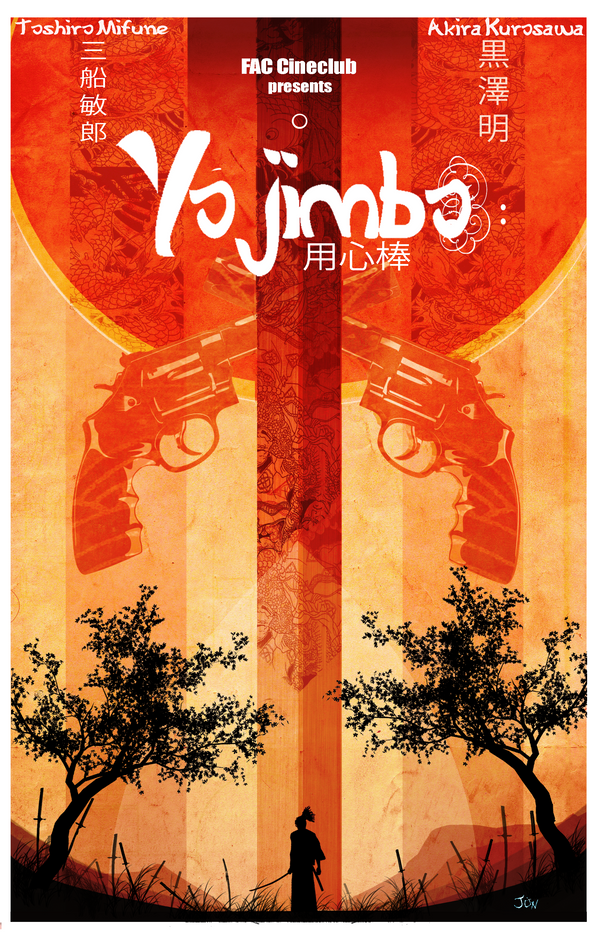most well known films
is a fun and
perfectly balanced
proto-action film.
At the time of it's release, Yojimbo was the highest grossing Kurosawa film in Japan and it remains one of the filmmakers most well known films to this day. It is also one of Kurosawa's most influential films, being the direct inspiration for Sergio Leone's Dollars Trilogy, the trilogy which breathed new life into the American western. Therefore it is quiet hard to remove Yojimbo from it's historical significance. However, I'm going to try.
Like many Kurosawa films, Toshiro Mifune (who now has a comfy seat waiting for whenever I bring him up) is the star and gives a phenomenal performance, perhaps his most iconic of all. Sanjuro is a selfish, cynical and manipulative drifter who leeches off the gang leaders of the film's town setting, and loves every second of it. Mifune is having a blast with this role, and yet is still able to give an underlying hint of nobility and justice to the character. Sanjuro is perhaps the perfect image of the travelling vagabond, one of the most enduring characters in modern culture directly because of this film. Other than Sanjuro, the film is occupied by several other characters who would go on to become highly recognisable icons with other westerns/samurai films. It is truly fascinating to witness where all these recognisable character archetypes originate from, and how wonderfully their first incarnations were portrayed.
Outside of the performances, the film features some of Kurosawa's most sturdy cinematography. The film has a very horizontal aesthetic, with a large focus upon horizontal lines and sweeping empty streets. This style would later evolve into the iconic showdown at the end of The Good, The Bad and the Ugly. Similar to the acing, it is stunning to see where such a well known and finely tuned visual style was birthed from, and how effective it was even at that point. The use of weather within this film is particularly impressive, rain emphasizing tension and frustration and mist showing the growing intensity and impending violence of the situation.
Yoimbo offers some of the most impressive scenes within Kurosawa's filmography. Particularly the rivalry between Sanjuro and the revolver twirling brother of one of the mob bosses. Merely with the blocking of the actors and the framing of the image, a powerful rivalry between the witty samurai and the powerful gun-warrior. Also, the earth-shattering sequence which shows Sanjuro at his lowest point is genuinely hard to watch and serves to harshly cut through the lighthearted and darkly-comedic tone of the film up to that point. Mifune owns these scenes with his posture and physical presence, two aspects of the actor which I don not think he has been matched on by any other.
In conclusion, Yojimbo is another of Kurosawa's masterpieces and has become a pillar of film culture. I personally would not hold it as one of my favourite Kurosawa's, I tend to prefer either his more epic and bombastic films or his tight character dramas. Despite this however, this is a must see in my eyes and deserves all the attention it has received since it's release.
By Jack D. Phillips
A Zoom Film Review
Like many Kurosawa films, Toshiro Mifune (who now has a comfy seat waiting for whenever I bring him up) is the star and gives a phenomenal performance, perhaps his most iconic of all. Sanjuro is a selfish, cynical and manipulative drifter who leeches off the gang leaders of the film's town setting, and loves every second of it. Mifune is having a blast with this role, and yet is still able to give an underlying hint of nobility and justice to the character. Sanjuro is perhaps the perfect image of the travelling vagabond, one of the most enduring characters in modern culture directly because of this film. Other than Sanjuro, the film is occupied by several other characters who would go on to become highly recognisable icons with other westerns/samurai films. It is truly fascinating to witness where all these recognisable character archetypes originate from, and how wonderfully their first incarnations were portrayed.
Outside of the performances, the film features some of Kurosawa's most sturdy cinematography. The film has a very horizontal aesthetic, with a large focus upon horizontal lines and sweeping empty streets. This style would later evolve into the iconic showdown at the end of The Good, The Bad and the Ugly. Similar to the acing, it is stunning to see where such a well known and finely tuned visual style was birthed from, and how effective it was even at that point. The use of weather within this film is particularly impressive, rain emphasizing tension and frustration and mist showing the growing intensity and impending violence of the situation.
Yoimbo offers some of the most impressive scenes within Kurosawa's filmography. Particularly the rivalry between Sanjuro and the revolver twirling brother of one of the mob bosses. Merely with the blocking of the actors and the framing of the image, a powerful rivalry between the witty samurai and the powerful gun-warrior. Also, the earth-shattering sequence which shows Sanjuro at his lowest point is genuinely hard to watch and serves to harshly cut through the lighthearted and darkly-comedic tone of the film up to that point. Mifune owns these scenes with his posture and physical presence, two aspects of the actor which I don not think he has been matched on by any other.
In conclusion, Yojimbo is another of Kurosawa's masterpieces and has become a pillar of film culture. I personally would not hold it as one of my favourite Kurosawa's, I tend to prefer either his more epic and bombastic films or his tight character dramas. Despite this however, this is a must see in my eyes and deserves all the attention it has received since it's release.
By Jack D. Phillips
A Zoom Film Review

No comments:
Post a Comment